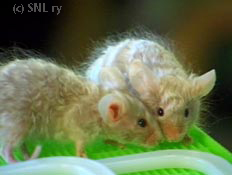Mice
The Mouse Care Basics
Introduction to mice
Mickey Mouse is certainly world's most famous mouse. From his ancestors Mickey has inherited many of his characteristics; curiosity, friendliness and courage. No wonder mice have been popular pets throughout times. Mice come in a whole variety of different colours and coats. Therefore mouse breeding is very interesting and challenging.
There are two different types of pet mice. The smaller type has different names in different countries, in Finland it's called the Finnish type, in Sweden Swedish and in the USA American type! The larger is commonly referred to as English Show mouse. The smaller one of these types is the one you usually see in pet-shops. It has smaller size and ears than the show mouse, and is usually also much livelier.
Light coloured English show mice can be massive in size for a mouse. They can weight 60g, while its smaller cousin weights only 20g. Dark coloured show mice do not usually grow to be as big as the light coloured ones. A show mouse has huge ears and long & racy back.

Curly mouse babies |
There isn't that great difference between a male (= buck) and female (= doe) mouse. A buck is usually slightly more massive and its pee has a stronger smell. However, this doesn't mean that males and females are hard to tell apart! Male mice have longer distance between the anus and the urethra than female mice do. When mice are of the weaning age, males are easy to tell apart by their prominent testicles. The life span of a mouse varies according to its ancestors. Usually a mouse lives to be app. 1-1? years, sometimes 2. Mice can reproduce as early as 1-1? months old. Therefore the babies should be separated by sex already when they're 3 weeks old. Does come into heat every 3-5 days and the gestation period is 18-21 days. Mice get a lot of babies in a litter, 10-20, depending on the age and size of the doe. So, it is better not to breed your pet mouse if you are not interested in really starting to breed mice.
Equipment
Mice thrive in a small group of 4-5 animals. Bucks may be very aggressive towards each other, so they are better kept alone.
To house your mouse, a plastic terrarium is most suitable -- mice can easily squeeze out of a cage. Another good option is a glass tank with wire lid, although it is harder to clean due to the weight. For bedding, do not use pine or cedar -- aspen shavings are a better option. You can also try other products available in your area. Never use saw dust or sand! They are dusty and can harm the mouse's eyes or coat. You should provide your mouse's home with toys; empty toilet paper rolls and cardboard boxes of different sizes (Kleenex, biscuit boxes...) that mice love to gnaw. For a nest, a flowerpot or empty coconut shell is more than suitable. You can give your mouse a wheel to run in. Choose a wheel that is big enough and safe. Too small a wheel may cause the mouse's tail to curve over its back.
Feeding
Mice are pretty easy to feed. Their main diet is mixture of seeds and grains -- hamster mixes do well. If the mix has a lot of sunflower seeds or nuts in it, you should remove part of them. A mouse can gain too much weight from fatty food. You should also add every once in a while dog (or cat) dry food. There are also "lab blocks" you can feed your mouse. Blocks designed for rats suit mice well. In addition to seeds or blocks, you should give your mice fresh food. Different fruits and vegetables are very good -- apple, cucumber, tomato, pear, salad. Always wash and/or peel the vegetables well. Every once in a while, give your mouse dried bread or dog biscuit to gnaw to prevent the mouse's teeth growing too long.
Along with the above-mentioned diet, you can give your mouse different kinds of porridges, mashed potato, boiled pasta or rice. Add a little live culture yoghurt or processed sour milk/cream, they have lots of calcium. Especially pregnant and nursing does, as well as growing babies need calcium.
You should feed your mouse always at the same time of day, preferably in the evening. The amount of food given depends on the size of the mouse. Pregnant and nursing does should be given as much food as they will eat and add a few drops of vitamin solution into the drinking water.
Always give your mouse water to drink, not milk. Water must be available at all times and it should be changed daily.
Care
It is quite easy to take care of mice. Even great show stars do not need trimming or other time taking care. Daily care includes washing of food bowl and water drinking bottle. Hot water is sufficient for daily wash, but a couple of times a week they should be washed with as hot water as possible with a little dish-washing liquid added, using a brush. Remember to rinse the dish-washing liquid off carefully.
Mice are usually very tidy animals and have a special potty corner. This corner should be cleaned daily to diminish mousy smell considerably. Most mice learn to use a potty box, which is a small bowl filled with kitty litter. This box is easy to clean daily and fill with clean litter.
You should clean you mouse tank or cage at least once a week, preferably more often. Usually the mouse owner's nose (or the mouse owner's mother's nose ;-?) tells when mouse tank isn't cleaned often enough. Wash the tank or cage using shower and brush and mild dishwashing solution. Do remember to rinse the solution off carefully.
You have to check the mouse's health daily. Mice are short-lived little animals and their illnesses break quickly. A mouse that is fine and happy in the evening can be all sick and hunched up, with coat standing up, sitting in the corner of the cage.
How to Play With Your Mouse
A healthy mouse is lively and curios and eager to explore the "whole wide world". To do this, it can gnaw its way out of the cage. Mice learn quickly to climb into its owner's hand (especially if you offer treats) and then up to the shoulder. Mice also love to explore pockets to see if there are any treats in there, and to run inside sleeves . You shouldn't wear your best clothes while playing with mice -- there may appear tiny little holes in the clothes.
You can construct a labyrinth from cardboard rolls and boxes and put nicely smelling treats in the end of the labyrinth. You can also construct a miniature fence tract and coax your mouse to run it through. Mice love to be caressed and scratched gently behind the ear.
